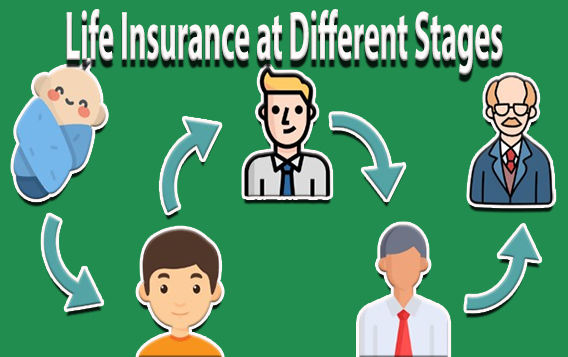When choosing a life insurance plan, there are various stages and factors to consider. When comparing life insurance choices, it’s critical to analyze your existing situation to identify the best course of action. Furthermore, it is critical to examine your situation and be prepared to switch between different life insurance policies, since they provide different benefits at different stages of life.

Your requirement for life insurance will change as your life evolves. When you are young, you normally do not need life insurance, but as you get older and raise a family, this changes. Your need for life insurance may then decrease when your obligations begin to reduce once more.
Life Insurance at Different Stages
Our financial demands, requirements, and commitments change as we proceed through life’s journey. For example, marriage typically increases financial responsibilities, which remain constant as the family grows and children are born. The value of insurance varies based on the individual’s life stage. To guarantee your dependents’ financial security, you must carefully arrange your insurance portfolio at different stages of life.
Let’s examine how your requirements for life insurance change throughout the different stages of your lifetime.
Single
Life insurance is something that single adults, no matter their age, often neglect. You don’t have a partner or kids who rely on you financially; you are self-sufficient. When it comes to life insurance, there are still options to take into account. If you die, your co-signer will be responsible for all debt payments, including loans and mortgages, on your behalf.
Giving your loved ones the expense of your final days of life is another risk you may avoid. If you’re financially supporting your aging parents, consider cash-value life insurance to build assets for future retirement income.
Newly married
Since you’ve added a spouse to your life at this point, life insurance may be important. The first step is to determine how much coverage is required to replace future income loss and pay off any large debts that may burden your spouse. Use our life insurance calculation tool first, then contact a financial advisor to discuss the results and next actions.
Proud parents
You always have your child’s best interests in mind as a parent. It is advisable to take life insurance into account while making plans. Budget for future child-rearing expenses, considering increased education costs and, if applicable, stay-at-home parent coverage.
College Education
Some parents even think about purchasing life insurance for their children in addition to themselves. Insurance can cover unforeseen burial costs or potentially build cash value for children’s college expenses, depending on the type of insurance.
Empty nesters
Time indeed flies, yet you now proudly own a peaceful new house. Since your children are grown and no longer living at home, you might not want as much life insurance at this point. However, if you are married and still employed, you should still have protection. To make sure you have everything covered, it is best to focus on estate planning with your financial advisor at this point.
Retired
Well, you’ve retired. What a wonderful sensation. But this is just the beginning of your financial future planning. Depending on your retirement preferences and long-term planning, you might not need as much coverage at this point. However, you should still discuss your overall financial strategy with your financial representative. You can now utilize the cash value of your life insurance policy to increase your retirement savings.
What Life Insurance Policy Do You Need Now
Your insurance needs will vary depending on where you are in life. You can determine how much coverage you need with the aid of our life insurance calculator. We provide three types of life insurance policies: term, whole, and universal life. Life insurance provides financial security in later life, but it should not be used to replace disability income or long-term care coverage.
Final Thought
Life insurance is more than just a safety net; it’s a useful travel companion. Knowing the differences between different life stages and choosing the suitable insurance plan will ensure a bright future in addition to protecting your loved ones. Additionally, act with the utmost compassion today to make tomorrow better and less stressful.

